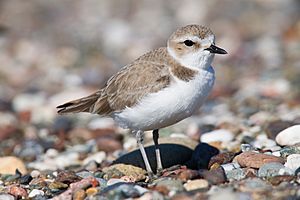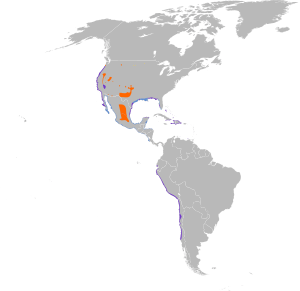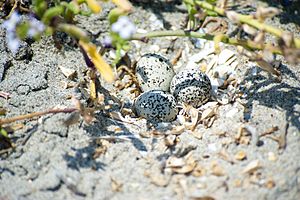Snowy plover facts for kids
Quick facts for kids Snowy plover |
|
|---|---|
 |
|
| Snowy plover near Cayucos, California | |
| Conservation status | |
| Scientific classification | |
| Genus: |
Charadrius
|
| Species: |
nivosus
|
 |
|
The snowy plover (Charadrius nivosus) is a small shorebird. It belongs to the plover bird family. These birds are usually about 5 to 7 inches long. They live and have their babies in places like Ecuador, Peru, Chile, parts of the southern and western United States, and the Caribbean islands. For a long time, people thought the snowy plover was just a type of another bird called the Kentish plover. But now, scientists know it's its own special kind of bird!
Contents
About the Snowy Plover
Snowy plovers are small birds. Here are some facts about their size:
- Length: They are usually about 5.9 to 6.7 inches (15 to 17 centimeters) long.
- Weight: They weigh about 1.1 to 2.0 ounces (32.5 to 58 grams). That's about as much as a few strawberries!
- Wingspan: When their wings are spread out, they measure about 13.4 to 17.0 inches (34 to 43.2 centimeters) across.
Snowy plovers look a bit different from their relatives. They have shorter legs and are lighter in color. Their feathers are more grey than other plovers. Male snowy plovers do not have a reddish-brown cap on their heads during breeding season. Also, the dark mask around their eyes is often faint or missing.
Where Snowy Plovers Live and Travel
Snowy plovers like to live on sandy coasts. They also live near salty inland lakes. You won't often find them near fresh water. They make their nests right on the ground. These nests are just small scrapes in the sand. A female plover usually lays three to five eggs.
Birds that live in warmer countries usually stay in one place all year. But snowy plovers from northern and inland areas travel. They are migratory birds. This means they fly south to warmer places for the winter. They often go to the tropics.
In North America, snowy plovers have their babies from Texas and Oklahoma west to California. They also live along the coast up to Oregon and Washington. Most of the coastal snowy plovers live and breed in central and southern California.

Protecting Snowy Plovers
On March 5, 1993, the western snowy plover was listed as a threatened species. This means it was protected under the Endangered Species Act. As of June 19, 2012, the beaches where they live along the California, Oregon, and Washington Coasts were called "critical habitat." This means these areas are very important for the birds' survival.
In 2016, experts looked at the risks to snowy plovers. They found that the number of snowy plovers was going down. It has become hard for these birds to have their babies on beaches. This is because people and their pets often disturb the nesting areas.
University of California, Santa Barbara Efforts
The University of California, Santa Barbara (UCSB) is working to help snowy plover populations. They protect beaches along the central California coastline. These beaches are near the university campus. UCSB has had some success in helping the birds reproduce. The university also trains students and volunteers. These helpers watch over the protected beaches during the day. They make sure no one bothers the nesting birds. Even with these efforts, the population is still slowly shrinking. It is thought that only about 2,500 western snowy plovers breed along the Pacific Coast.
Vandenberg Air Force Base Efforts
The beaches at Vandenberg Air Force Base in California are also important. They have several protected areas for snowy plovers. Breeding has been successful there in recent years. People can only go to these beaches at certain times of the year. Only very specific areas are open to keep the birds safe. Most of these beaches are only for military staff and their families.
What Snowy Plovers Eat
Snowy plovers that live by the coast look for food near the water's edge. They also hunt in drier, sandy areas. Birds that live inland prefer wet environments. They usually find food by running a bit, then pausing, and then running again. Sometimes, they will poke their beaks into the sand. They also chase insects near dead animals.
These birds mainly eat small creatures without backbones. This includes crustaceans, worms, beetles, and especially flies.
See also
 In Spanish: Chorlitejo blanco para niños
In Spanish: Chorlitejo blanco para niños



